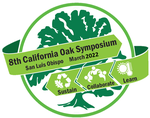#27

Protecting in situ Engelmann oak within a broad ex situ collection of Quercus species
Nicole Cavender, The Huntington
Tim Thibault, The Huntington, Curator, Woody Plant Materials
Though still nascent, The Huntington has a uniquely integrated oak conservation program involving in situ conservation of Quercus engelmannii, ex situ conservation collections of US and Mexican oak species, as well as an herbarium, field program, tissue culture lab and cryopreservation research. This breadth of activity is particularly important for exceptional species like oaks.
Working within the broader botanic garden plant conservation community, The Huntington is a partner in multiple subregions of the newly formed Global Conservation Consortium for Oak (GCCO), including the Western US Subregion that includes California. The primary purpose of the GCCO is to coordinate conservation activities on threatened oak species, based on data from both the International Union for Conservation of Nature (IUCN) Red List and the Conservation Gap Analysis of US Native Oaks (CGA). As no one institution can house the diversity of oaks, GCCO uses a metacollection approach that shares germplasm across multiple sites. The Huntington currently holds significant ex situ collections of several oak species for the GCCO, including the California native Quercus dumosa.
Balancing these conservation activities becomes particularly tricky with Quercus engelmannii. IUCN lists numerous threats to Quercus engelmannii, including urbanization, agriculture, change in fire regimes, habitat shift and hybridization. Quercus engelmannii is considered a particularly promiscuous oak species and steps need to be taken to limit chances of pollination by other species, especially those in the same section of the genus, including Quercus dumosa for example. Arrangement of the collections becomes an issue, but ameliorated by creating an in situ preserve for the site native species and limiting other species in the same section of the genus to downwind sites. Additionally, the CGA identifies critical needs for population reinforcement, as well as for education, outreach and training for Quercus engelmannii that The Huntington is well positioned to fulfill as one of only 19 collections to hold the species. An overview of current oak conservation activities is provided with an eye to finding additional partners.
